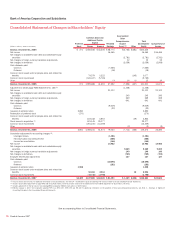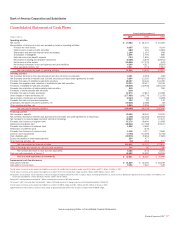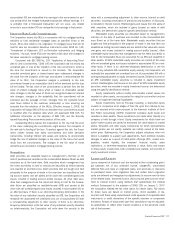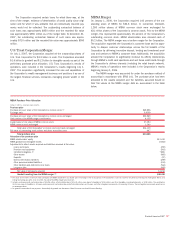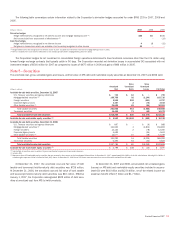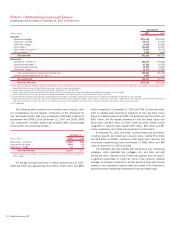Bank of America 2007 Annual Report Download - page 126
Download and view the complete annual report
Please find page 126 of the 2007 Bank of America annual report below. You can navigate through the pages in the report by either clicking on the pages listed below, or by using the keyword search tool below to find specific information within the annual report.Assets”) with the carrying amount of that goodwill. An impairment loss is
recorded to the extent that the carrying amount of goodwill exceeds its
implied fair value. In 2007, 2006 and 2005, goodwill was tested for
impairment and it was determined that goodwill was not impaired at any of
these dates.
Intangible assets subject to amortization are evaluated for impair-
ment in accordance with SFAS No. 144 “Accounting for the Impairment or
Disposal of Long-Lived Assets.” An impairment loss will be recognized if
the carrying amount of the intangible asset is not recoverable and exceeds
fair value. The carrying amount of the intangible is considered not recover-
able if it exceeds the sum of the undiscounted cash flows expected to
result from the use of the asset. At December 31, 2007, intangible assets
included on the Consolidated Balance Sheet consist of purchased credit
card relationship intangibles, core deposit intangibles, affinity relation-
ships, and other intangibles that are amortized on an accelerated or
straight-line basis over anticipated periods of benefit of up to 15 years.
There were no events or changes in circumstances in 2007, 2006, and
2005 that indicated the carrying amounts of the Corporation’s intangibles
may not be recoverable.
Special Purpose Financing Entities
In the ordinary course of business, the Corporation supports its custom-
ers’ financing needs by facilitating the customers’ access to different fund-
ing sources, assets and risks. In addition, the Corporation utilizes certain
financing arrangements to meet its balance sheet management, funding,
liquidity, and market or credit risk management needs. These financing
entities may be in the form of corporations, partnerships, limited liability
companies or trusts, and are generally not consolidated on the Corpo-
ration’s Consolidated Balance Sheet. The majority of these activities are
basic term or revolving securitization vehicles for mortgages, credit cards
or other types of loans which are generally funded through term-amortizing
debt structures. Other special purpose entities finance their activities by
issuing short-term commercial paper. The securities issued from both
types of vehicles are designed to be paid off from the underlying cash
flows of the vehicles’ assets or the reissuance of commercial paper.
Securitizations
The Corporation securitizes, sells and services interests in residential
mortgage loans and credit card loans, and from time to time, automobile,
other consumer and commercial loans. The accounting for these activities
is governed by SFAS No. 140, “Accounting for Transfers and Servicing of
Financial Assets and Extinguishments of Liabilities – a replacement of
FASB Statement No. 125” (SFAS 140). The securitization vehicles are
qualified special purpose entities (QSPEs) which, in accordance with SFAS
140, are legally isolated, bankruptcy remote and beyond the control of the
seller. QSPEs are not included in the Corporation’s Consolidated Financial
Statements. When the Corporation securitizes assets, it may retain
interest-only strips, one or more subordinated tranches, subordinated
interests in accrued interest and fees on the securitized receivables and,
in some cases, cash reserve accounts which are generally considered
residual interests in the securitized assets. The Corporation may also
retain senior tranches in these securitizations. Gains and losses upon
sale of the assets are based on an allocation of the previous carrying
amount of the assets to the retained interests. Carrying amounts of
assets transferred are allocated in proportion to the relative fair values of
the assets sold and interests retained.
Quoted market prices are used to obtain fair values of senior retained
interests. Generally, quoted market prices for retained residual interests
are not available; therefore, the Corporation estimates fair values based
upon the present value of the associated expected future cash flows. This
may require management to estimate credit losses, prepayment speeds,
forward interest yield curves, discount rates and other factors that impact
the value of retained interests. See Note 8 – Securitizations to the Con-
solidated Financial Statements for further discussion.
Interest-only strips retained in connection with credit card securitiza-
tions are classified in other assets and carried at fair value, with changes
in fair value recorded in card income. Other retained interests are recorded
in other assets and/or AFS debt securities and are carried at fair value or
amounts that approximate fair value with changes recorded in income or
accumulated OCI. If the fair value of such retained interests has declined
below its carrying amount and there has been an adverse change in esti-
mated contractual cash flows of the underlying assets, then such decline
is determined to be other-than-temporary and the retained interest is writ-
ten down to fair value with a corresponding adjustment to other income.
Other Special Purpose Financing Entities
Other special purpose financing entities (SPEs) (e.g., Corporation-
sponsored multi-seller conduits, collateralized debt obligations, asset
acquisition conduits) are generally funded with short-term commercial
paper. These financing entities are usually contractually limited to a nar-
row range of activities that facilitate the transfer of or access to various
types of assets or financial instruments and provide the investors in the
transaction protection from creditors of the Corporation in the event of
bankruptcy or receivership of the Corporation. In certain situations, the
Corporation provides liquidity commitments and/or loss protection agree-
ments.
The Corporation determines whether these entities should be con-
solidated by evaluating the degree to which it maintains control over the
financing entity and will receive the risks and rewards of the assets in the
financing entity. In making this determination, the Corporation considers
whether the entity is a QSPE, which is generally not required to be con-
solidated by the seller or investors in the entity. For non-QSPE structures
or VIEs, the Corporation assesses whether it is the primary beneficiary of
the entity. In accordance with FASB Interpretation No. 46 (Revised
December 2003), “Consolidation of Variable Interest Entities, an inter-
pretation of ARB No. 51” (FIN 46R), the entity that will absorb a majority of
expected variability (the sum of the absolute values of the expected losses
and expected residual returns) consolidates the VIE and is referred to as
the primary beneficiary. For additional information on other SPEs, see Note
9 – Variable Interest Entities to the Consolidated Financial Statements.
Fair Value
Effective January 1, 2007, the Corporation determines the fair market
values of its financial instruments based on the fair value hierarchy estab-
lished in SFAS 157 which requires an entity to maximize the use of
observable inputs and minimize the use of unobservable inputs when
measuring fair value. The standard describes three levels of inputs that
may be used to measure fair value which are provided on the following
page. The Corporation carries certain corporate loans and loan commit-
ments, loans held-for-sale, structured reverse repurchase agreements, and
long-term deposits at fair value in accordance with SFAS 159. The Corpo-
ration also carries trading account assets and liabilities, derivative assets
and liabilities, AFS debt and marketable equity securities, MSRs, and
certain other assets at fair value.
124
Bank of America 2007




